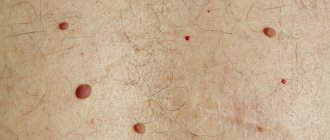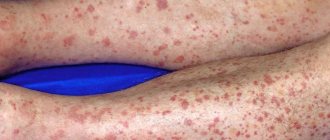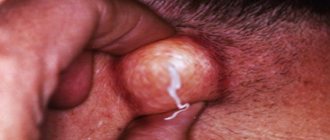One of the most common types of skin diseases is acne. Today, pharmacological and cosmetic companies offer a huge number of drugs that make it possible to combat this defect, but what to do if acne forms in the groin of women?
This is a rather sensitive situation, since most women are ashamed to see a doctor, and torment themselves day after day with possible causes of their illness. In addition to itching and burning, acne in the intimate area also causes psychological discomfort - a woman cannot have a full sex life or visit public pools and beaches.
Pimples in the groin in women Causes?
The reason is not always obvious, but there are several reasons why you may have acne around your genitals. Some of them are:
Contact dermatitis
Vaginal acne in women is likely caused by contact dermatitis. Contact dermatitis in the groin can be caused by sensitivity to:
- bubble bath procedures using aggressive soaps, especially if they contain strong fragrances,
- feminine wipes, deodorants, lotions, powders or perfumes,
- tampons or sanitary pads,
- spermicides, condoms, lubricants or sexual stimulants,
- antibiotic drugs,
- washing powders that you use to wash your underwear.
Your skin may also become irritated due to:
- Sweating due to wearing synthetic underwear and tight jeans,
- vaginal discharge,
- urine ingress,
- sperm.
Any skin irritation can lead to acne formation.
Rash and pimples on a girl's pussy
Girls at any age can develop pimples and rashes on the genitals, which are formed due to the influence of various factors, including the development of:
- diaper dermatitis - is a diaper rash that appears due to prolonged interaction with the surface of the diaper, the baby's feces and lack of circulation of moisture and air. It looks like purulent rashes, swelling of the skin, spots, bumps and redness in the groin;
- allergies - caused by food intake, manifested by redness and erythema of the skin;
- overheating - has the appearance of red spots (prickly heat), which form in the inguinal folds of girls and do not cause discomfort, characterized by the appearance of a red rash, spots and watery pimples on the genitals of girls;
- candidiasis - caused by a fungus of the genus Candida affects the genital area in girls, characterized by a red rash.
Treatment of rashes and pimples on the labia in girls requires medical supervision.
Disinfectants and drying agents are prescribed for affected areas of the skin. These can be ointments, creams, pastes and powders. In addition, you can use herbal decoctions of nettle, chamomile, string and other herbs.
We recommend reading
Other causes of acne in the groin in women
Poll: When did your acne appear? (Number of votes: 4295)
About a few months
To vote, click on the desired answer. results
Some lesions may appear to be pimples, but are actually cysts, warts, or other skin conditions in the groin area. The most common ones are:
Bartholin's cysts - usually found near one side of the vaginal opening. If the cysts do not go away within a few days or become painful, see your doctor. Large cysts can be a major symptom of a type of vulvar cancer called Bartholin's gland cancer.
READ ALSO: Acne again at 35: how to get rid of age-related acne
Genital herpes are lesions that can look like pimples in the groin area of women. They appear around the vagina, vulva and anus. Genital herpes can only be treated under the strict supervision of a physician, because it is a fairly serious infectious disease.
Genital warts can also be mistaken for groin pimples. You can have a single wart or even a cluster of small warts. They are caused by the human papillomavirus (HPV), a common sexually transmitted infection (STI).
Folliculitis: Pimples in the genital area can be the result of an infection of the hair follicle caused by various infections. Shaving pubic hair is one of the potential causes of folliculitis and red pimples in the groin To avoid irritation, shave only in the direction of hair growth. In some cases, hair grows in the opposite side, and shaving them can cause not only inflammation, but also ingrown hairs.
Sliding a razor over sensitive skin can also cause the following symptoms of irritation:
- "razor burn"
- pimple-like bumps
- rash of small pimples
- pimples.
Inversion acne is a chronic disease of the sweat glands. The disease causes pimple-like lesions on the body, including the groin area. The cause of this rare inflammatory disease is unclear. There are symptoms but no cure yet.
Molluscum contagiosum is a viral infection that can cause pimples anywhere on the body, including the groin in women. Treatment is not always necessary, but it can be treated with topical or oral medications. If necessary, your doctor can remove the pimple yourself.
According to the place of manifestation
Pimples differ not only in appearance and the reasons that led to their formation, but also in location. Depending on the location of the formation of the rash, special therapy may be carried out, requiring special medications and acne removal techniques. The most dangerous and difficult to diagnose are pimples located on the labia minora and in the vagina.
Pimple on the small lip in women
photo of a pimple on the small lip of a woman
Pimples on the labia minora can appear due to various factors:
- failure to comply with personal hygiene measures;
- abuse of soap during hygiene procedures, which leads to dryness of the epithelium, irritation of tissues and cracks in the skin through which bacteria penetrate;
- herpetic eruptions primarily affect the mucous membranes, which means that quite often they form watery pimples on the labia minora;
- Venereal diseases can also provoke the formation of acne of various types on the labia minora.
If a pimple bothers you, causes itching, burning, or peeling, then you will need the help of a qualified specialist, since it is almost impossible to determine the type of rash on the sebaceous labia from a photo from the Internet.
Vaginal rash
A rash in the vagina is detected during an examination by a gynecologist. This problem is serious and requires careful study and treatment in the future. As a rule, a rash in the vagina in women is formed due to:
- Inflammatory processes of the Bartholin gland, which is localized at the entrance to the vagina. The causes of inflammation can be a history of gonorrhea, mycoplasmosis and trichomoniasis.
- A pimple in the vagina is not a simple formation, but can be a boil on the labia or a carbuncle. The reasons for the formation of such growths can be a vaginal cyst, paraurethritis and urethral diverticulum.
- Herpes virus infection, condylomas and even molluscum contagiosum can be located in the vagina. These diseases are transmitted primarily through sexual contact, which means it is necessary to avoid unprotected sexual intercourse.
READ ALSO: Acne on the legs of women and men: reasons why legs itch and pimples appear
There are quite a few types and causes of acne in the vagina. When a formation is detected, diagnosis and treatment should be carried out exclusively by a specialist. For treatment, specific therapy with antibacterial drugs of local and systemic action, immune-supporting treatment is used, and antiseptics are also used.
Purulent and bloody pimple in the groin of women
A boil, or skin abscess, is the main cause of purulent and, in more severe stages, bloody pimples in the groin in women and men. A boil is an accumulation of pus that forms in the skin and includes symptoms and signs such as:
- hard, reddened swelling
- sensitive, swollen skin around a large pimple,
- the swelling can vary in size - from a small pea to a large walnut, but even the smallest boil is larger than a regular pimple in size and shape.
- rapid filling of the boil with pus, which can spontaneously increase to sizes that are non-standard for a pimple.
Only antibiotics prescribed by your doctor are an adequate treatment for abscesses and boils. Primary treatments for inflammation include warm compresses and drainage (opening by piercing) of the abscess, but only when it is soft and ready to drain pus.
READ ALSO: Hormonal pills for acne - on the face, for women and men, list, reviews
The procedure must be carried out by a doctor under sterile conditions with special instruments. Most purulent boils resolve on their own or with the help of home remedies and compresses. Bloody pimples and boils require urgent medical attention.
Squeezing a cystic pimple
How to treat a bloody pimple on the pubis or groin at home?
Most boils and small blood pimples will go away on their own within a few days or weeks. You can help relieve symptoms and speed up the healing process with these home remedies:
Before touching the boil or the area surrounding it, be sure to wash your hands well. Use antibacterial soap and warm water. Without this step, you risk introducing a large number of bacteria and germs into the boil, which can make the infection even worse.
Likewise, wash your hands after you finish your treatment if you don't want to risk spreading any bacteria to other areas of your body.
Rules and methods for treating blood acne on the pubis or groin
Do not squeeze or poke the pimple
Resist the temptation to squeeze or remove a blood pimple yourself. By doing this, you release bacteria that can spread the infection to nearby private areas. It can also make the pimple inflamed even worse, causing it to flare up and become painful.
Apply a warm compress
Soak a pre-disinfected warm cloth with water that is slightly warmer than room temperature. Squeeze out excess water. Place the compress on the area of the bloody pimple and leave it there for 7 to 10 minutes.
Repeat this process three or four times a day until the boil goes away. The heat from the compress helps increase blood circulation so white blood cells can fight any remaining infection.
Avoid wearing tight pants or jeans to cure a bloody pimple.
One of the most common causes of bloody pimples on the pubic or groin and even labia is tight, tight clothing, which causes friction on the sensitive thin pubic skin Until the boil disappears, wear loose underwear and clothes After training, also remember to immediately switch to clean , dry underwear.
Use ointments for acne and inflammation
Antibiotic erythromycin ointment can help protect the skin of the groin and pubic area from blood pimples, inflammation, and kill bacteria and viruses that cause this more severe form of acne. o Erythromycin ointment for acne! .
Take over-the-counter pain relievers
Over-the-counter pain relievers may be needed to relieve pain and inflammation caused by boiling. Use medications such as Ibuprofen or Acetaminophen according to package directions.
If these home remedies do not help or the boils do not go away within two weeks, make an appointment with your gynecologist or primary care physician as you may need urgent medical treatment from a doctor.
Is it safe to squeeze a pimple in the groin?
It is better not to even try to squeeze out a vaginal pimple on your own. On the one hand, squeezing the pimple can lead to the spread of bacteria and the development of infection. On the other hand, irritation very easily occurs in this sensitive area, which will only worsen your condition.
The pimple may become inflamed, even filled with pus, and continue to grow at a blisteringly fast pace over the next few days. As it grows, it may also become painful.
Do not poke or squeeze pimples near the genitals (there is a chance that the pimple may burst on its own). Instead, see a doctor who will perform the removal procedure in a way that prevents infection.
What to do if a pimple appears in an intimate place
The appearance of acne in the intimate area can be either a cause for concern or an occasional occurrence caused by minor errors in diet or hygiene.
In any case, even a small problem should not be ignored, because sometimes it can result in significant discomfort.
Well, if there are suspicions that the cause of the rash is not entirely harmless, then this is a good reason to consult a doctor.
- All information on the site is for informational purposes only and is NOT a guide to action!
- can give you an ACCURATE DIAGNOSIS !
- We kindly ask you NOT to self-medicate, but to make an appointment with a specialist !
- Health to you and your loved ones!
Internal and subcutaneous pimple in the groin in women
Internal and subcutaneous pimples are 99% of the time the cause and symptom of cystic acne - the most serious and painful type of acne. It develops quite rapidly when cysts form deep under the skin. It can be the result of the activation of certain bacteria, oil and dead skin cells that become trapped in your skin. pores.
Cystic acne tends to occur in people with oily skin. This condition is also more common in teenagers, women, and older adults with hormonal imbalances.
Typically, cystic internal and subcutaneous acne goes away with age. However, persistent and painful acne will not go away on its own. If you suspect that you have cystic acne, an urgent visit to a dermatologist will be your best decision towards cystic acne treatment.
Types and locations of acne in intimate areas
Pimples in the intimate area may vary in color, size or intensity of manifestation.
Usually these are sufficient symptoms to determine their specific variety. Let's look at what rashes can form in a sensitive area and what can cause them.
White bumps may appear on the skin surrounding the genitals.
They look like small tubercles rising above the surface. The white color is figuratively attributed to them; sometimes such rashes can simply have the color of the rest of the skin, but appear visually and to the touch.
- If small lumps resembling “goose bumps” appear on the skin, then these may simply be hair follicles. These are completely natural formations on the skin from which hairs grow, so they should not cause concern. A dense area near the mouth of the follicle may appear due to the accumulation of dead epidermal cells. In this case, it is enough to treat this area well with a medium-hard washcloth during hygiene procedures to get rid of these pimples;
- Sebaceous glands may appear as white pimples. They are also present in other parts of the body, but since the skin in the delicate area is thinner, the glands become noticeable. Otherwise, they may actually be hypertrophied. This usually occurs over the age of 30. In both the first and second cases, no treatment is required. And, although the sebaceous glands will not become smaller over time, this does not foretell any adverse changes in human health.
Photo: irritation after shaving pubic hair
- allergic reactions to synthetic underwear or taking any medications. In this case, one of the symptoms is itching. The pimples themselves are small and may have watery contents. They are located in the groin. on the butt or pubic area; Usually, stopping contact with the allergen or ingesting it causes rapid regression of the rash;
- dermatitis. Acne is similar to allergic acne. only when the allergen is withdrawn they do not go away. Often areas of these red rashes are located in the groin area or on the butt. A doctor should be involved in the treatment, who will prescribe treatment based on the specific situation;
- irritation from shaving or depilation. Such rashes are also red, small, and scattered. Their distinctive feature is their formation exactly in the procedure area. The reason is damage to the epidermis by a razor or depilatory compound.
Watery
Watery pimples in the intimate area require special attention.
Their causes may be:
- hormonal imbalance;
- allergic reaction;
- prickly heat, a consequence of overheating or insufficient ventilation of the skin under synthetic underwear;
- infectious diseases.
The last point is the most important, therefore, to exclude the infectious nature of the rashes, it is better to immediately consult a doctor.
This color is not typical for ordinary acne. A subcutaneous pimple can turn black if the accumulation of pus disrupts the integrity of small blood vessels. Usually the area around the pimple is swollen and feels hard to the touch.
Upon closer examination, a black pimple may turn out to be a mole or wart.
But to determine its nature, you should contact a specialist, for example, a dermatovenerologist.
Inflamed
An inflamed red pimple may appear due to hormonal imbalance or poor hygiene.
In the latter case, bacteria begin to actively multiply in the pore clogged with contaminants. Such pimples can be located in the upper layers of the skin or go deep inside.
If a purulent element has formed under the skin, it will be painful.
Internal acne can appear on the pubic area, on the butt, in the groin, and even on the outer surface of the labia in women.
If a pimple like this breaks out, it needs to be treated as soon as possible.
Be especially careful when placing it in the groin, because there are lymph nodes nearby, and the infection can quickly spread throughout the body.
Fat cysts
Fatty cysts are formed when the duct of the sebaceous gland from above becomes overgrown with the epidermis.
Photo: fatty cysts on the scrotum
Sebum accumulates underneath it, having no way out, and hardens. Externally, it looks like a white tubercle up to 1 cm in diameter.
READ ALSO: Benefits of natural cosmetics
Such cysts often appear in boys during puberty on the penis or scrotum.
They do not cause pain or discomfort, but do not go away on their own.
If the cyst suddenly begins to increase in size, it is removed surgically. The operation is short and simple.
Video: “Genital herpes”
Infectious
A pimple on an intimate place in women and men can be a sign of a sexually transmitted infection, especially if a person knows that he had sexual contact with a dubious partner without protection.
You may notice that such a pimple has appeared in the perineum, on the labia or penis, in the anus or on the pubis. Typically, infectious rashes manifest themselves with additional symptoms.
Photo: with sexually transmitted diseases, the rashes have an unusual appearance
Among the manifestations of rashes caused by sexually transmitted infections, the most common are:
- burning;
- itching;
- increased body temperature;
- enlarged inguinal lymph nodes;
- discharge from the genitals.
If acne appears strange in appearance or one of the listed signs is present, you should contact a gynecologist or dermatovenerologist as soon as possible.
One of the most serious diseases transmitted both sexually and at home.
Due to the fact that in the early stages its symptoms are not pronounced, syphilis becomes chronic.
- The first sign of the disease is the formation of ulcers (hard chancre) or pustules on the mucous membrane of the genital organs. This symptom may not exist or the formations may be located in inconspicuous places (for example, on the inner walls of the vagina), which makes early diagnosis difficult.
Photo: ulcerative lesions of the female genital organs
- After 2-3 months of infection, a dark red rash appears on the body. It can be vesicular, pustular or in the form of spots. The rash is accompanied by a sore throat, malaise, and low-grade fever.
- If treatment is not carried out, the disease goes into an asymptomatic stage, but the patient serves as a source of infection for others. At this time, irreversible scar changes occur in the osteochondral tissue, blood vessels or nerve fibers.
Genital herpes
Herpes is very easily transmitted through unprotected sex, and its symptoms appear on the third day.
- These are rashes in the form of blisters, which usually form on the pubis and mucous membranes of the external genitalia.
Photo: rashes with genital herpes
- The blisters itch. accompanied by a burning sensation, the skin around them swells. After a few days, ulcers and crusts form at the site of the vesicular rash, which subsequently heal without leaving marks.
Herpes is prone to frequent relapses; moreover, it is completely impossible to cure it.
The triggering factor may be stress, a cold, or pregnancy. any decrease in immunity.
Bartholinitis
Bartholin's glands are located on the labia minora.
If their duct is blocked, the secretion of the gland cannot be released and forms a thickening. This occurs when infected with gonococci and staphylococci. E. coli, chlamydia.
Is it worth using Azelik acne ointment?
Is it possible to quickly treat acne at home? Find out here.
At first glance, it may seem that a large pimple has popped up on the labia.
- It causes discomfort and interferes with walking and sexual intercourse.
- Such formations are very painful.
You should immediately contact a gynecologist before the cyst becomes too large.
Pediculosis pubis
Photo: manifestations of pediculosis pubis
Pubic lice are blood-sucking parasites that are transmitted through contact, both through sexual intercourse and through the use of another person’s hygiene items.
- Despite the fact that their usual habitat is pubic hair, they can migrate to eyelashes, eyebrows, and armpits.
- The lice bites are very itchy, and after 2-3 days small red pimples appear in their place.
Molluscum contagiosum
It is transmitted through skin contact with an infected person.
Photo: molluscum contagiosum
- The formation that appears is slightly different from a pimple; it is denser, hemispherical in shape, pink in color with a pearlescent tint.
- There is a small depression inside the formation, and when pressed, a thick white mass is released.
- Molluscum contagiosum does not cause pain.
Depending on the disease diagnosed by the doctor, treatment methods differ.
- Syphilis. Antibacterial therapy with penicillin, cephalosporins or macrolides is prescribed. The duration of therapy depends on the stage at which the disease was detected.
- Genital herpes. It is impossible to completely cure the disease. During the period of exacerbation, antiviral drugs and agents for treating rashes are taken to reduce itching and burning.
- Bartholinitis. In this disease, the cyst is marsupialized (removed). To prevent infection, a course of antibiotics is given. Relapses occur in approximately 10% of cases.
- Pediculosis pubis. To get rid of blood-sucking parasites, it is enough to shave off all the hair on the pubic area or in the armpits (that is, remove their habitat). You can use special sprays and shampoos.
- Molluscum contagiosum. The disease can go away on its own within 6 months to a year. Both surgical treatment (electrocoagulation, cryodestruction, laser excision) and medication (mainly aimed at strengthening the immune system) are possible.
How are acne in the groin usually treated?
Pimples caused by minor irritation may go away on their own without much consequence. If they do not go away, or if the skin in the groin area worsens significantly, consult a doctor.
Acne in the groin in women caused by contact dermatitis can be treated with medications that are prescribed individually to each patient. If an allergic reaction is diagnosed, antihistamines can be prescribed.
If you are diagnosed with contact dermatitis, your doctor will first need to determine the cause of its formation through an external examination and based on the results of a skin analysis. You will also need to stop using any cosmetic products in the genital area.
READ ALSO: Pimples on the head in the hair - causes of appearance, methods of treatment
Pimples caused by ingrown hairs also usually go away on their own. Early diagnosis and self-treatment of pimples caused by ingrown hairs can only make the situation worse. Also, treatment is not always necessary for molluscum contagiosum. If it doesn't go away on its own within a week, your doctor may prescribe a topical or oral medication for its prompt removal.
If you don't know what's causing your acne, avoid using any medications and seek advice from your doctor to avoid making the situation worse.
In most cases, acne goes away on its own or with the help of additional treatment within a few weeks. The predicted result of treatment depends on the causes of acne in the groin and the chosen treatment methods. Your doctor can give you a more precise answer to the question of what you can expect.
You may need to make some adjustments to your personal hygiene routine to prevent the skin condition in your groin area from recurring.
Treatment of blood acne on the labia, pubis and groin
Bloody pimples on the labia, pubis or groin can often go away on their own. If this does not happen within 10 days, then treatment options will include:
The first step to applying the right treatment is to identify the cause of such pimples.
Pay attention to the appearance of vaginal pimples and any foods, activities or other factors that may affect their appearance in the labia or pubic area, including shaving, using too hot bath water when masturbating. Also be tested for sexually transmitted or infectious diseases or an allergic reaction of the labia or pubis to hygiene or chemical products for washing underwear or skin care.
Remove irritants
Once the cause of the irritation or infection has been identified, stop using the product, treatment, or activity that is causing the pimples.
For example, if it's shaving, reduce irritation by using a new blade and shaving in the direction of hair growth. Also avoid using oils on the skin as they can trap bacteria in the follicles.
Ideal hygiene in intimate areas should be maintained
The warmth and moisture in the genital area make it an ideal place for bacteria and other microorganisms to thrive.
Avoid using harsh or greasy soaps that are not intended for intimate hygiene as they can affect the pH balance, which can lead to infection.
Choose cotton underwear and avoid synthetic fabrics. Choose loose, comfortable clothing that allows your skin to breathe, and always change clothes and underwear after exercise. Change tampons or pads regularly during menstruation.











